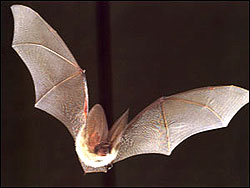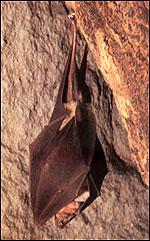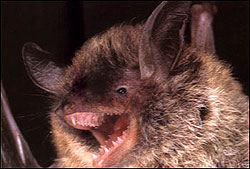The secret life of bats
By Phil Richardson
Bat structure
Bat bones are relatively thin and light to help with the problem of weight and flight. Flight requires plenty of energy, so the lighter the bones, the better. A bat that was as heavy as a similar-sized non-flying mammal would not only need to have incredibly strong flight muscles, but would be using up energy at a very rapid rate, probably faster than it could supply it, just to counteract the downward pull of gravity. The comparative lightness of bats means that they are manoeuvrable and agile in the air.
Skull

The skull of a megabat (right) measuring 7 cm: the long snout helps it to smell fruit, the flattened molars are for crushing fruit, and its large eye sockets contain big eyes for good vision in the dark. The skull of a microbat (left) measuring 4 cm: it has a relatively short snout and lower jaw.
The skull of any mammal always reveals much about how the animal lives, and so it is with bats. Apart from fruit bats, all bats have the skull attached to the spine by special vertebrae that enable them to bend their necks backwards, so that they can hang straight down in a roost and arch their heads back to look around. The teeth of insect-eating bats have sharp, spiky edges so that the upper and lower jaws work rather like scissors and can chop up the hard outer-body casings of insects. The front teeth are usually very small to prevent interference with their echolocation pulses. Fruit bats have flatter molars that work better when mashing the pulp of fruit.
Forearms
When at rest, a bat holds its forearms along the sides of its body. The forearm can be measured easily and its length is used widely to help identify different species. Forearm length is a very good guide to the size of the whole bat. A very small bat has a forearm that is 3 cm long, whereas very large bats have forearms as long as 15 cm. A few millimetres may not sound much, but they represent a noticeable difference in the size of the whole bat - a bat with a 4 cm forearm looks much bigger than one with a forearm measuring 3.7 cm.
Legs and wings
Two other major differences between the skeletons of bats and those of other mammals are the structure of the wings and the legs. The wings are the most remarkable feature of bats. Like humans, bats have 4 fingers and a thumb on each hand, but the fingers are very long - each about as long as the body - and very thin. The thumb is relatively small and has a claw that is used for gripping when the bat is at rest, whereas the fingers have lost their claws (except in many fruit bats of the Old World, which have a claw on their second finger).
The legs are attached so that the knees bend the opposite way to those of humans: backwards and outwards instead of forwards. This enables bats to move more rapidly on all fours across a surface such as a cave roof, rather like a spider; it also helps them to squeeze quickly into narrow crevices to escape predators. For those species with a tail membrane, backward-flexing knees enable them to move the attached membrane downwards in flight to aid food catching and aerial manoeuvring.
Flight

The rubbery skin of the wing membranes of this long-eared bat, Plecotus, occupies a large area, and joins to the legs. It is criss-crossed with blood vessels.
Humans have tiny flaps of skin joining the bases of their fingers. Bats have a much, much larger double-thick membrane of skin (called the patagium) that joins their long fingers from the bases to the tips. The fingers cannot be flexed independently, but muscles in the arm can open up the hand, so producing a wing rather like opening up an umbrella, where the spokes of the umbrella give the cloth covering strength and shape. The surface area is made even larger by the main inner part of the membrane (the plagiopatagium) joining to the side of the bat's body and all the way down to the legs. The human equivalent would be to have thin, spindly fingers 2m long stretching out from your hands and covered in material that also reached from the side of your arm and hand down to your ankle, joining up to your leg and the side of your body. It would limit your activities greatly, as you could no longer use your hands for gripping, pushing or levering. Stretch out your arms and fingers, however, and you have a massive surface area that, if flapped up and down with sufficient force, could give you lift.
The energy needed for a bat to fly is enormous - to power its flight muscles a bat's heart-beat rate goes up from about 300 beats a minute at rest to 1,000 beats a minutes in flight. The curved surface of a bat's wing provides lift, if it is moving forward fast enough. On the upstroke the wing partially folds, so that it is easier to raise and does not push the bat downwards, but it regains its shape on the downstroke.
Glossary
Calcar Spur of cartilage from the heel that supports the trailing edge of the tail membrane.
Forearm length The length between the end of the elbow and the wrist, which is used to give an indication of the overall size of the bat.
Interfemoral membrane Membrane of skin joining the back legs and often enclosing the tail.
Molar Flat teeth at the back of the mouth, used for grinding.
Plagiopatagium Membrane of skin on the wing between the fifth finger, the forearm, the body and the leg.
Propatagium Part of the wing membrane in front of the forearm, from the thumb to the body.
The leading edge has a flap of skin (the propatagium) that can be adjusted to prevent stalling when manoeuvring. Leg and arm movements can adjust the surface area and shape of the wings to allow turns, banking and deceleration. Bats can even use a wing to catch a flying insect and transfer it into their mouths in flight. Having solid skin covering the wing enables a bat to carry out sudden changes of direction, whereas the 'leaky' feathers of a bird's wing may allow air to pass through, causing the bird to drift when it tries to change direction suddenly.
Also, with wings made of skin, any damage generally heals quickly. The flight membranes are criss-crossed with tiny blood vessels to keep each area of skin healthy. Bats carefully groom their wings to keep the skin in good condition, using oils secreted from glands to help, rather like using hand cream after washing one's hands. Flight by bats has to be powerful, since their mass changes significantly at different times in their lives. After hibernation a small Myotis bat may weigh 7g, but when about to give birth she may have increased this to 14g, and has to be able to fly with this extra weight. After the birth, a female may need to carry her youngster around - the youngster may be well over half its mother's weight. After only a couple of hours feeding, a bat's increase in mass can be well over 50 percent, and fruit bats may fly off with a heavy fruit in their jaws.
Tail membranes
Many microbat families have a full membrane of skin - the interfemoral membrane - joining their back legs and completely enclosing the tail. It is used in flight to brake and change direction, but perhaps its major use is related to feeding. As the bats are flying with their hands, they cannot use them effectively to grab a flying insect that they encounter. Instead they fly over the prey and curl down their tail to form a catching device. Still in flight, the bat can then curl its head and neck down and transfer the insect to its mouth. The bat then eats it as it flies along. There is a strengthening sliver of cartilage along the trailing edge of the membrane joined to the feet, rather like a thin sixth toe, called the calcar. Where extra strength is required in some species, such as the fishing bat Noctilio leporinus, this can stretch along most of the trailing edge of the tail membrane.
Get a grip!

A greater horseshoe bat, Rhinolophus ferrumequinum, hibernating. The curved toes and claws grip tightly even when the bat is in a deep sleep. (Image: Phil Richardson)
With their front limbs highly modified for flight, most bats find moving around on the ground difficult. They can support the front of their bodies on their wrists, but have no fingers to grip with, or paws equipped with pads to soften their progress. When not flying, bats tend to rest by hanging from high places. In that way they can drop down and gain some speed to make it easier to fly off again. To facilitate hanging, they have well-developed curved claws on their toes that they hook around a branch or other suitable surface. The tips of the claws are very sharp, so bats can obtain a grip on some of the smoothest surfaces. The toes can be spread to enable the claws to grip at different angles to improve their purchase. In larger species, the claws can be hooked right around a branch.
An extremely neat adaptation is the arrangement of the ligaments and muscles in the leg, which, when relaxed, keep the foot in the clenched position. This means that the bats can fall asleep and not drop off, rather like hanging down beneath a grappling iron. It takes the bat some effort to open its foot and release its grip, the opposite way to how our hands work. The feet support the weight of the bat, but some species also use the single claw on their thumbs to improve the grip, so ensuring that their whole body is in contact with the roosting surface. Bats also use their thumb claws to hang from when giving birth and in some species when urinating and defecating. When out feeding, fruit bats may land briefly on a tree branch in order to pluck off a fruit or feed on nectar from a flower, and at such times they use their thumbs to grip the branch. They also use them to help manipulate large food items into the mouth. Most megabats have a second claw on the second finger, but this is smaller and not really functional.
A coat of fur

The dense fur of bats such as this Brandt's bat, Myotis brandtii, insulates and protects its owner. (Image: Phil Richardson)
All mammals have hair on their bodies, although it may be sparse in the case of whales and a few other mammals. The body of a bat has a dense covering of fur that in some species spreads out onto part of the wing and tail membranes. For many species living in the temperate areas of the world warm fur is essential to insulate them against the cold. It also serves well as body protection, particularly for those bats that squeeze their delicate little bodies into narrow, rough crevices to roost.
The individual hairs are unusual in appearance when viewed under a microscope, each having jagged edges and looking rather like a stack of miniature paper cups with uneven rims. As yet the exact function of this unusual structure is not known.
Most species have brown or black fur, often paler beneath, but there are a few oddities amongst bats. Some are almost naked and others are bright orange or all-white, or have coloured patches and stripes in their fur or frosted tips to the hairs. It may seem odd for bats, which are usually active only at night, to have coloured fur, but it seems to be restricted to species that roost outside in daytime, in which it probably has a camouflaging effect. Even the few species, such as the little Central American Ectophylla alba, that have all-white fur look greenish when hanging beneath large green leaves.
Around a bat's mouth, feet and tail membranes there are special touch-sensitive hairs (whiskers and bristles) that help it catch its food. The faster-flying bats have sleek fur and those feeding close to water have a dense, waterproof fur.
Toolbox

Last year nearly 100,000 specimens were loaned to scientific institutions and researchers worldwide.